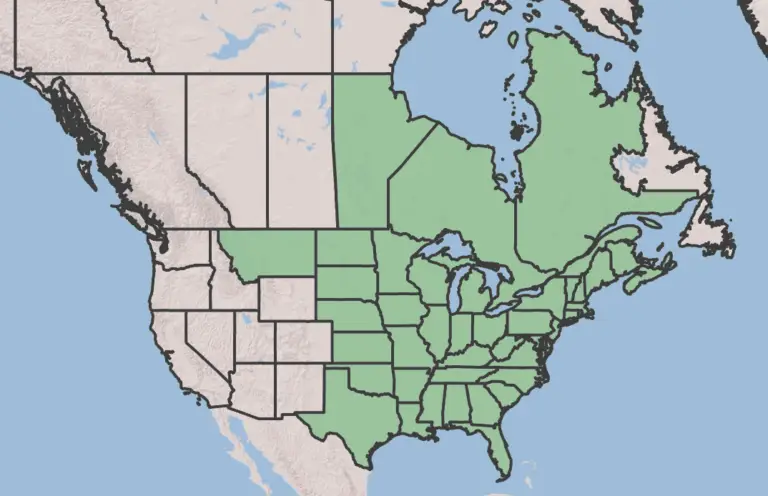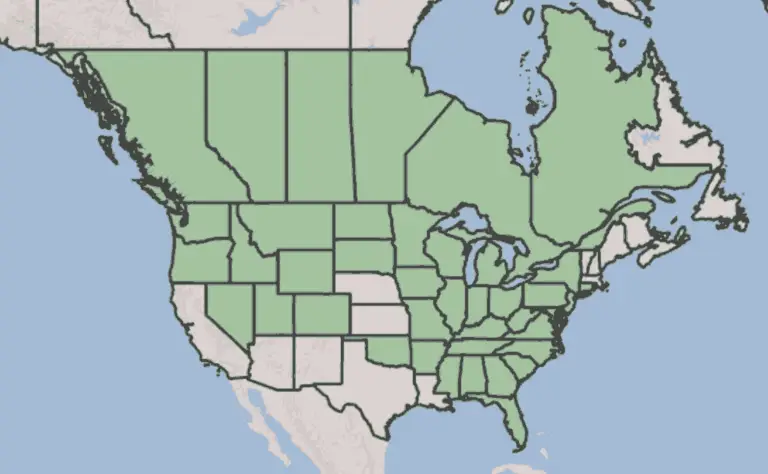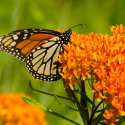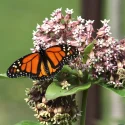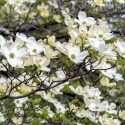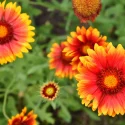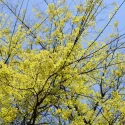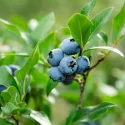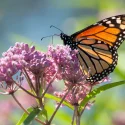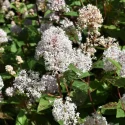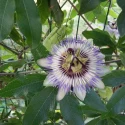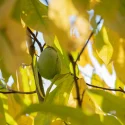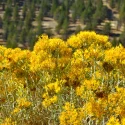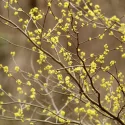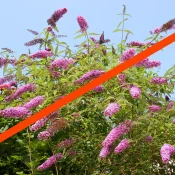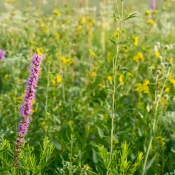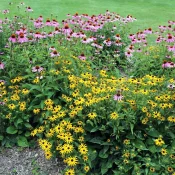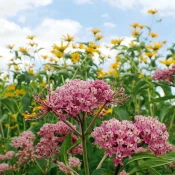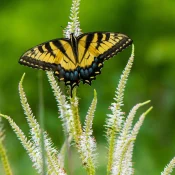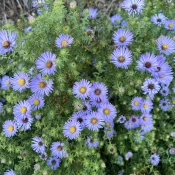Golden Alexander
Want something bright, cheery, and filled with butterflies from the spring to early summer? Golden Alexanders are for you. Their yellow flowers can bloom from April to July. After they bloom, their leaves remain to provide garden greenery throughout the summer. Most importantly, Golden Alexanders are host plants for Black Swallowtail butterflies. Scroll on for planting tips.
- Full Sun, Part Sun
- Medium (3-5')
- Spring flowers
- Host Plant
Golden Alexander's shape is a perfect butterfly landing pad
If you’re looking for something bright for your garden that helps support butterflies and pollinators, Golden Alexander is a great choice (Zizia aurea and Zizia aptera are these two species’ Latin names). Native to a large portion of the United States, these easy-to-grow flowers look amazing in yards, help pollinators when in bloom, and feed birds in the fall. In this article, we’ll explore the wonders of Golden Alexander, including how to grow, its host plant abilities, and its history. Let’s dig in, shall we?
Golden Alexander is a native plant
Golden Alexander has grown in North America for thousands of years, making it a native plant. This beautiful native plant has a lot to offer, from its bright yellow flowers to its ability to support local butterflies.
Native plants are important for any garden. Native plants help give food and shelter to birds, butterflies, and pollinators. Native plants make gardening easy—established native plants just need rain to be happy.
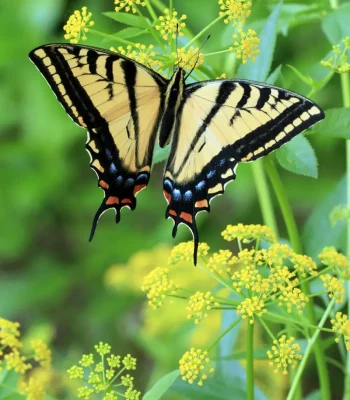
Golden Alexander is a part of the parsley family
(Zizia aurea, Zizia aptera)
Golden Alexander is a member of the parsley family, and its leaves and stems have a similar appearance to other members of this family. The plant can grow up to 3 feet tall, with yellow flowers that bloom in the late spring and early summer. The leaves are bright green and have a serrated edge. It grows in sunny areas and is commonly found in meadows, prairies, and along roadsides.
Golden Alexander vs. Queen Anne’s Lace
You’ve probably seen a white version of Golden Alexander on the sides of highways or on hikes, especially in the Northeast or Midwest. The white-flowered version is known by its common name ‘Queen Anne’s Lace.’
Sadly, Queen Anne’s Lace is not native to North America. (Unsurprisingly, due to its fancy English name, it’s native to Europe.)
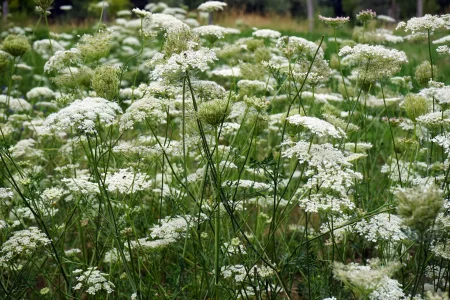
Queen Anne’s Lace
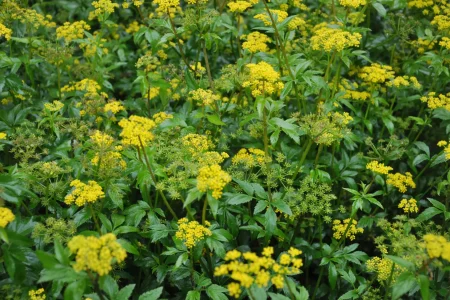
Golden Alexander
What are the benefits of having Golden Alexander in my garden?
There are many reasons to include Golden Alexander in your garden. Here are just a few:
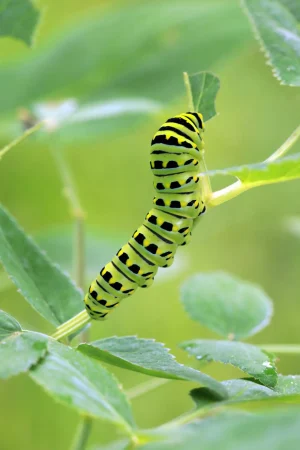
Golden Alexanders are host plants for Black Swallowtail butterflies
If you want to help out bees, butterflies, and other pollinators, Golden Alexander is perfect for you. Golden Alexander is a host plant for the Black Swallowtail butterfly. This means that it is an essential food source for this butterfly’s caterpillars. In addition, the plant’s flowers attract bees, butterflies, and other pollinators. By planting Golden Alexander in your garden, you can help support local wildlife.
There would be no Black Swallowtail butterflies without host plants like Golden Alexander.
What is a host plant?
A host plant is a specific plant that a bug, butterfly, or caterpillar eats, lives on, or lays its eggs on.
Golden Alexander will help your garden look beautiful
With its bright yellow flowers and attractive foliage, Golden Alexander is a beautiful addition to any garden. The plant’s height and texture make it an excellent choice for filling in gaps between taller plants (like Coneflower or Rattlesnake Master).
Golden Alexander saves time (+money)
Golden Alexanders are perennials, which means that the plants come back year after year. Plant once and enjoy for years.
Golden Alexander is a low-maintenance plant that requires little watering or fertilization once established. It also has a long blooming period, which means that you can enjoy its beautiful flowers for several weeks. Planting native plants gives you back time and money, especially compared to lawncare.
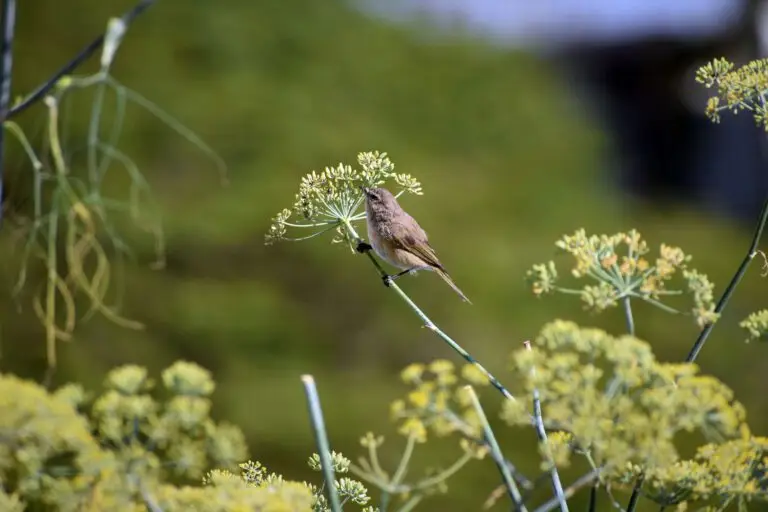
What is Golden Alexander’s native range?
Its native range depends on the species. The common name ‘Golden Alexander’ often includes two species of plants:
Golden Alexander
Zizia aurea
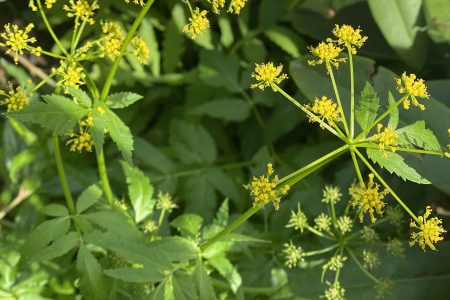
Same yellow flowers, but notice those sharp-pointed leaves?
This plant is native to most of the United States and Canada. You can plant Golden Alexander in the Northeast, Mid-Atlantic, Midwest, or the South along with the eastern half of Canada.
Heartleaf Alexander
Zizia aptera
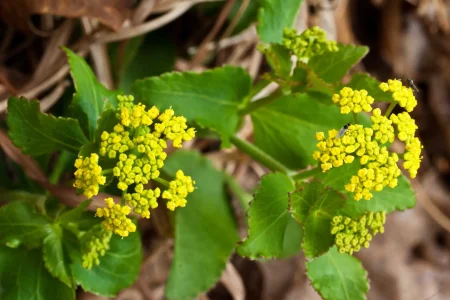
Same yellow flowers, but notice those rounded, larger leaves?
This plant is native to almost all of North America, and its range is huge! When sourcing seeds and plants that have huge native ranges, try to stick to sources within 800 miles to reap the benefits of plant provenance.
Wondering how to tell which is which when you’re at a local plant nursery? This is when Latin names come in handy. The Latin name will tell you which plant you’re looking at since all plants have only one Latin name. (If this seems a little academic, it’s a nice reminder that the Screen Actors Guild also has the same only-one-name rule.)
How to grow Golden Alexander
Good news—no matter the species, Golden Alexander is a plant that can handle a lot!
- It likes full sun but can also do well in part sun. The only light that won’t work is full shade.
- Golden Alexander can also thrive in a wide range of soils, from loam to clay.
- Golden Alexander is known for its ability to survive dry summers even though it prefers being consistently watered.
Golden Alexander’s flowers turn into seedheads, which often seed themselves in the garden. Plant a single Golden Alexander and you may have a patch of sunny bright flowers in a few seasons.
Grow it, Build it has a great overview video to give you an idea of its size and the benefits of planting Golden Alexander (Zizia aurea).
Grow Golden Alexander from seed
Golden Alexanders are easy to plant from seed and will flower the first year. If you’re starting from seeds, plant them in the fall or early spring.
Here are some online sources for Golden Alexander (Zizia aurea species) seeds:
- Everwilde Farms (Fallbrook, California)
- Prairie Moon (Winona, Minnesota)
As you pick a seller, a tip for you:
800-mile tip for seeds and planting
A big tip for picking seeds is to try to buy or obtain seeds from places that are within 800 miles (or less!) of where you live—the closer, the better. This ensures that the seeds you’re buying are suited for your area (Golden Alexander seeds from Maine are probably not the best seeds for a garden in Texas.)
Local blooms, fewer glooms
Find native plants near you
Local plants and seeds—grown within 800 miles—are best suited for your garden. This also fosters cross-pollination among locally grown plants, enhancing their resilience for generations to come. Stay local for a happy garden!
Grow Golden Alexander from plants
If you’re using transplants, plant them in the spring or early summer. Space the plants about 12 inches apart to allow room for growth. There are four reliable ways to find Golden Alexander plants:
Where can I find seeds and plants?
Finding native plants can be challenging (we partly blame Marie Antoinette.) To make it easier, we’ve assembled four sourcing ideas.
Native Nursery List
300+ native nurseries makes finding one a breeze
Online Native Plant Sellers
We've included 100+ online resources to help
Society Plant Sales
Every state has a native plant society; find yours
Online Communities
Local Facebook groups are a great plant source
Golden Alexander care
Golden Alexander is a low-maintenance plant, but it does require some care the first year. Water the plant regularly during the first year to help it establish its root system (this is called getting a plant established.) After that, the plant should be able to survive on its own. Deadhead the flowers as they fade to encourage the plant to produce more blooms.
How to use Golden Alexander
There are many ways to use Golden Alexander in your garden. Here are just a few:
Golden Alexander in meadow restoration
If you have a meadow or other natural area on your property, consider planting Golden Alexander to support local wildlife. The plant’s flowers attract bees and butterflies, while the foliage provides food for the Black Swallowtail butterfly.
Golden Alexander in landscaping
Golden Alexander is an excellent choice for adding color and texture to a garden. It works well as a border plant, a filler plant, or as part of a mixed planting. It also pairs nicely with other native plants. Bee Balm, Aster, Coreopsis, Nodding Onion, and Milkweed all grow well with Golden Alexander.
Golden Alexander is a beautiful and easy-to-grow plant that’s perfect for any garden in the Northeast, Mid-Atlantic, Midwest, or South. By following the simple care tips we’ve shared, you can enjoy its bright yellow blooms for years to come. The two species both off host plant benefits and provide bright pops of yellow for your garden. To get more ideas on native plant gardening, explore our native plant library. Or, keep exploring plants for butterflies in our Native Host Plants for Butterflies round-up. Happy planting!
Sources
- Harstad, Carolyn. Go Native!: Gardening with Native Plants and Wildflowers in the Lower Midwest. (1999), 213.
- Johnson, Lorraine. 100 Easy-to-Grow Native Plants for American Gardens in Temperate Zones. (1999), 62.
- Taylor, Patricia A. Easy Care Native Plants. (1996), 30-31.
- Lake Forest College, Golden Alexanders
- NC State Extension, Zizia aurea
- NC State Extension, Zizia aptera
- Missouri Botanical Garden, Golden Alexander
- Minnesota Board of Water and Resources, Golden Alexander. (PDF).
- USDA Plants Database, Zizia aptera
